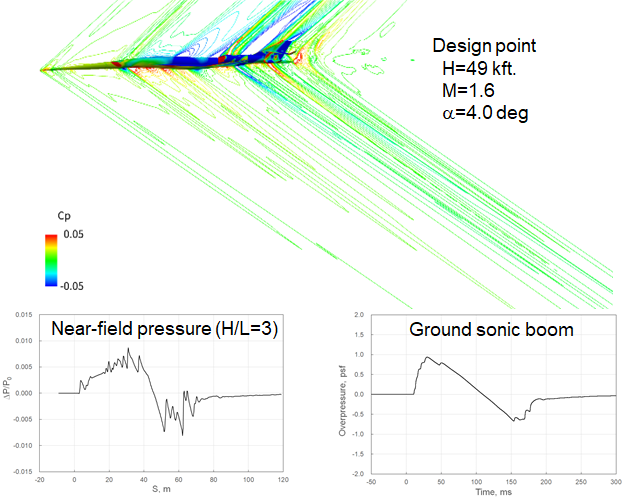Research and development for system integration of silent supersonic airplane technologies
JAXA Supercomputer System Annual Report April 2020-March 2021
Report Number: R20EA3800
Subject Category: Aeronautical Technology
- Responsible Representative: Yoshikazu Makino, Aeronautical Technology Directorate, Aviation Systems Research Unit
- Contact Information: Hiroaki Ishikawa(ishikawa.hiroaki2@jaxa.jp)
- Members: Junichi Akatsuka, Naoko Tokugawa, Hiroaki Ishikawa, Yoshine Ueda, Dongyoun Kwak, Keisuke Ohira, Atsushi Ueno, Satoshi Kondo, Tatsunori Yuhara, Ryo Shimada, Shinya Koganezawa, Hisato Takeda, Rei Yamashita, Yasushi Watanabe
Abstract
It is important to acquire world-class high level technology in order to enhance the international competitiveness of Japan’s aircraft manufacturing industry, especially for supersonic transport. In addition, the advantage is great, such as revitalizing economic activities from the business and tourism aspects by shortening the travel time of supersonic flight, and the health aspects of passengers such as suppression of economy class syndrome. Based on this, the purpose of this project is to acquire the key technologies required to realize a “quiet supersonic aircraft” and contribute to the development of the aircraft manufacturing industry and air transport in the future. In this project, R&D on sonic boom estimation, measurement and evaluation technologies will contribute to the formulation of international standards at ICAO required for over land supersonic flight. The integrated design technology that simultaneously satisfies both low boom, low drag, low noise and weight reduction are developed to present a concept of a supersonic transport that simultaneously satisfies these technical goals.
Reference URL
Please refer to http://www.aero.jaxa.jp/eng/research/frontier/sst/ .
Reasons and benefits of using JAXA Supercomputer System
To develop a future supersonic transport that satisfies the requirement of low sonic-boom and low aerodynamic drag, it is necessary to estimate aerodynamic properties and sonic-boom properties by accurate numerical simulation. JSS is used to estimate aerodynamic performances of various configurations with high accuracy and high efficiency for the designing of the low-boom supersonic transport.
Achievements of the Year
In order to realize a future low-boom supersonic transport, it is an important task to reduce sonic boom loudness in entire primary boom carpet both at on-track and off-track positions during climb, cruise, and descent flight phases. Sonic boom loudness on the ground during supersonic flight is affected by various factors such as altitude, flight speed, acceleration/deceleration, angle of attack, and flight path angle. In this study, the sensitivity analysis and the primary sonic boom carpet assessment for the JAXA’s conceptual low-boom supersonic transport named S4 are carried out. Sensitivity analysis of these factors on sonic boom loudness and creating an aerodynamic data map are performed by using CFD analysis. Then, trajectories that can be realized supersonic over-land flight are suggested from the obtained aerodynamic data map. Finally, the entire primary boom carpet is described with detailed CFD analysis and propagation analysis.
Publications
– Oral Presentations
Hiroaki Ishikawa, Atsushi Ueno, Shinya Koganezawa, Yoshikazu Makino, Bernd Liebhardt and Klaus Lutjens, “Sensitivity Study and Primary Boom Carpet Assessment for Conceptual Low Boom Supersonic Transport,” AIAA AVIATION 2020, 2020
Hiroaki Ishikawa1, Shinya Koganezawa and Yoshikazu Makino, “Near Field Sonic Boom Simulations for C608 airplane of the Third AIAA SPW by Unstructured/Structured Overset Grid Method,” AIAA Scitech2021, 2021
Atsushi Ueno and Yoshikazu Makino, “Robust Low-Boom Design in Primary Boom Carpet,” AIAA Scitech2021, 2021
Usage of JSS
Computational Information
- Process Parallelization Methods: MPI
- Thread Parallelization Methods: Automatic Parallelization
- Number of Processes: 128 – 512
- Elapsed Time per Case: 20000 Second(s)
Resources Used(JSS2)
Fraction of Usage in Total Resources*1(%): 0.67
Details
Please refer to System Configuration of JSS2 for the system configuration and major specifications of JSS2.
| System Name | Amount of Core Time(core x hours) | Fraction of Usage*2(%) |
|---|---|---|
| SORA-MA | 2,730,055.89 | 0.52 |
| SORA-PP | 195,388.27 | 1.53 |
| SORA-LM | 7,955.93 | 4.67 |
| SORA-TPP | 0.00 | 0.00 |
| File System Name | Storage Assigned(GiB) | Fraction of Usage*2(%) |
|---|---|---|
| /home | 438.01 | 0.40 |
| /data | 16,450.50 | 0.32 |
| /ltmp | 9,835.38 | 0.84 |
| Archiver Name | Storage Used(TiB) | Fraction of Usage*2(%) |
|---|---|---|
| J-SPACE | 12.69 | 0.42 |
*1: Fraction of Usage in Total Resources: Weighted average of three resource types (Computing, File System, and Archiver).
*2: Fraction of Usage:Percentage of usage relative to each resource used in one year.
Resources Used(JSS3)
Fraction of Usage in Total Resources*1(%): 0.46
Details
Please refer to System Configuration of JSS3 for the system configuration and major specifications of JSS3.
| System Name | Amount of Core Time(core x hours) | Fraction of Usage*2(%) |
|---|---|---|
| TOKI-SORA | 1,424,811.33 | 0.31 |
| TOKI-RURI | 168,845.22 | 0.97 |
| TOKI-TRURI | 0.00 | 0.00 |
| File System Name | Storage Assigned(GiB) | Fraction of Usage*2(%) |
|---|---|---|
| /home | 865.85 | 0.59 |
| /data | 34,367.49 | 0.58 |
| /ssd | 551.54 | 0.29 |
| Archiver Name | Storage Used(TiB) | Fraction of Usage*2(%) |
|---|---|---|
| J-SPACE | 12.69 | 0.42 |
*1: Fraction of Usage in Total Resources: Weighted average of three resource types (Computing, File System, and Archiver).
*2: Fraction of Usage:Percentage of usage relative to each resource used in one year.
JAXA Supercomputer System Annual Report April 2020-March 2021




